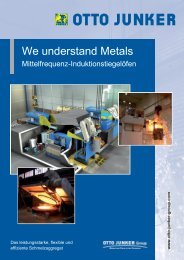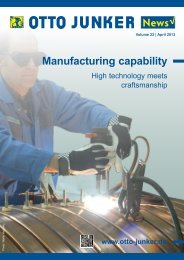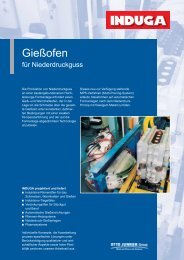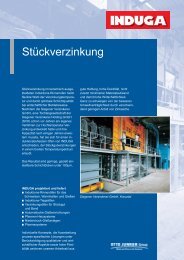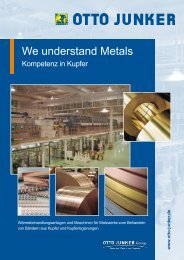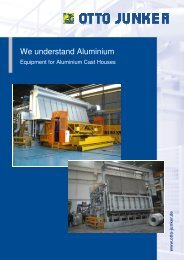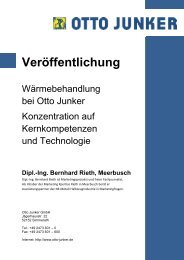Download Brochure Heat Treatment for Castings and Forgins 2012
Download Brochure Heat Treatment for Castings and Forgins 2012
Download Brochure Heat Treatment for Castings and Forgins 2012
Create successful ePaper yourself
Turn your PDF publications into a flip-book with our unique Google optimized e-Paper software.
<strong>Heat</strong> <strong>Treatment</strong> Systems <strong>for</strong> Suspension<br />
Components<br />
Wärmebeh<strong>and</strong>lungsanlage<br />
<strong>Heat</strong> treatment of automotive<br />
für Fahrwerkskomponenten<br />
suspension parts<br />
The system operates fully automatically. It consists of a<br />
loading station, a solution-annealing furnace, a water<br />
quench tank with lifting/lowering plat<strong>for</strong>m <strong>and</strong> attached<br />
drip-drying station, a traversing car, a straightening area,<br />
an artificial ageing furnace, an air cooling section <strong>and</strong> the<br />
unloading section.<br />
Richtmaschinen<br />
Straigtheners<br />
Wasser- Water<br />
Abschreckbad quench<br />
Stapel-/Entstapeleinrichtung<br />
Stacker /<br />
destacker<br />
Warmauslagerungs-<br />
Artificial ageing<br />
furnace Ofen<br />
Air<br />
Luftkühl-<br />
cooling<br />
station<br />
Unloading<br />
Entladestation with<br />
robot mit Roboter<br />
Console<br />
Pult<br />
All part h<strong>and</strong>ling operations are fully robotized. The<br />
recirculating air is directly heated using natural gas, with<br />
burners installed in the ducting. Inside the furnace the air<br />
is recirculated by powerful fans mounted on the furnace<br />
roof. The hot furnace atmosphere is applied to the<br />
charge from all sides. <strong>Heat</strong>ing is achieved by the highconvection<br />
principle. The entire furnace consists of<br />
multiple sections which can be separately controlled.<br />
Solution Lösungsglüh-Ofen annealing<br />
furnace<br />
Beladestation<br />
Loading<br />
station mit Roboter with<br />
robot<br />
Automotive manufacturers require absolute repeatability<br />
in the process management of safety part manufacturing.<br />
To this end, the furnace system complies with the<br />
following requirements:<br />
high temperature uni<strong>for</strong>mity <strong>and</strong> very precise<br />
temperature control throughout the furnace<br />
chamber;<br />
rapid <strong>and</strong> uni<strong>for</strong>m heating of each part <strong>and</strong> of the<br />
entire furnace charge;<br />
rugged <strong>and</strong> reliable low-wear conveyor system;<br />
minimum pre-cooling of parts between opening<br />
of the furnace <strong>and</strong> immersion in the quench,<br />
achieved through rapid part transfer;<br />
minimum possible de<strong>for</strong>mation of castings in the<br />
water quench;<br />
high degree of automation, avoiding manual<br />
intervention if at all possible;<br />
All process <strong>and</strong> h<strong>and</strong>ling sequences are<br />
controlled at plant level by PLC-equipped<br />
switchgear. Man/machine interfacing is based on<br />
a master visualization system. Various annealing<br />
parameters are stored in the <strong>for</strong>m of recipes.<br />
Current charge data are written to memory <strong>and</strong><br />
recorded at the end of the process.<br />
11 / 12



